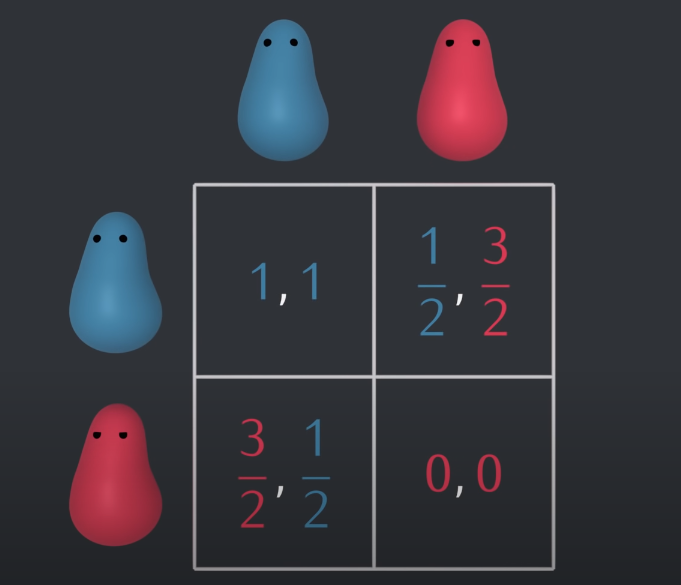Evolutionary game theory is a branch of game theory that deals with evolving populations in biology. Evolutionary game theory approaches problems from a slightly different perspective than traditional game theory, so I’m going to highlight some of the differences. In evolutionary game theory, the players are presumed to be animals in a population. These animals don’t make rational decisions and instead stick to a pre-programmed strategy. This single hardwired strategy could represent a specific genetic trait of the animal, for example, the color of its camouflage or its behavior in certain social situations. Since the strategies are hardwired to the animal’s genetics, information at the time of the decision is not used or relevant. Payoffs in evolutionary game theory do not represent a preference for the animal, but instead Darwinian fitness, which is the expected reproduction capability the animal provides for future generations of the species.
A common example in evolutionary game theory is the game of hawks and doves. I’m going to describe a simplified version of this game as discussed in this excellent video. In the fictional world of birds, there is a finite amount of food that replenishes every day. The food appears in pairs of two. Every day the birds must fly out to find food to survive and reproduce. A bird can only visit one food source each day which is selected randomly, and there is a chance that another bird can arrive at the same food source. There are two strategies for the birds. The first is the dove, which shares the food even if it encounters another dove, but only takes a small amount and flees if threatened. The other strategy is the hawk. The hawk threatens for food if it encounters another bird. If it encounters a dove it gets the majority of the food, and if it encounters another hawk they fight, and both die. Here is the payoff matrix with blue representing doves, and red representing hawks.

When we simulate the world of the birds for many generations, the dove and hawk strategy always forms an equilibrium, where there is an equal amount of doves and hawks. This is because if your opponent is a hawk, then the best option is to be a dove. If the opponent is a dove, the best option is to be a hawk. It’s always an advantage to be playing the strategy that isn’t the majority. Due to natural selection, the two strategies always arrive at the same 50/50 equilibrium.

One of the primary concepts of evolutionary game theory is the idea of evolutionary stable strategies (ESS). An ESS is a strategy that if all members of a population played that same strategy, then there is no other strategy that would experience a better payoff than the original strategy. An ESS is stable because there isn’t a different strategy that could overcome it. There is no stable strategy in the world of birds. If all birds were playing the dove strategy the expected value of playing hawk would be better, and if all animals were playing the hawk strategy then playing a dove would be better.
The final topic of evolutionary biology I would like to discuss is the potential for altruistic behavior to develop. Imagine a world with a bunch of monkeys and lions. The lions periodically attempt to eat the monkeys. When a monkey sees a lion, there are two behaviors that the monkey can express. The monkey can go secretly hide, which guarantees its survival but causes another monkey to get ambushed and eaten, or the monkey can alert the other monkeys around him of the danger, which guarantees all other monkeys survive but puts themselves at risk, though they do still have a chance at survival.

In traditional game theory, an individual monkey should always go and hide, but in evolutionary game theory the monkeys don’t make rational decisions. Over hundreds of generations, due to natural selection, the groups of monkeys who alert others, risking their safety end up becoming the strategy, and therefore altruistic behavior becomes the dominant strategy in this world. Evolutionary game theory is an incredibly interesting subfield of game theory. It introduces interesting topics such as altruism, and has applications in many other fields such as economics, biology and memetics. I hope this post provided you with a simple introduction to EGT. I hope that I’ve sparked an interest in EGT and some of you will go on to do more reading and learning about the subject.
Thank you for reading!
https://wisc.pb.unizin.org/agent-based-evolutionary-game-dynamics/chapter/0-1/
https://plato.stanford.edu/entries/game-evolutionary/
https://www.youtube.com/watch?v=YNMkADpvO4w
One reply on “Introduction to Evolutionary Game Theory”
This was an incredibly interesting read, thank you for sharing! I definitely want to read more about Evolutionary Game Theory in the future. The examples you provided, with the dove vs hawk and the monkey vs lion do a great job of illustrating the different strategies that could be played and the equilibriums that could be attained. I found it particularly interesting how the monkey chooses to warn its fellow monkeys, ultimately playing a strategy that isn’t quite as beneficial for itself, but ultimately plays out much better for the wellness of its species! Definitely puts a different perspective on things. I wonder, if we based our strategies on similar altruistic principles, could we further our evolution as well?